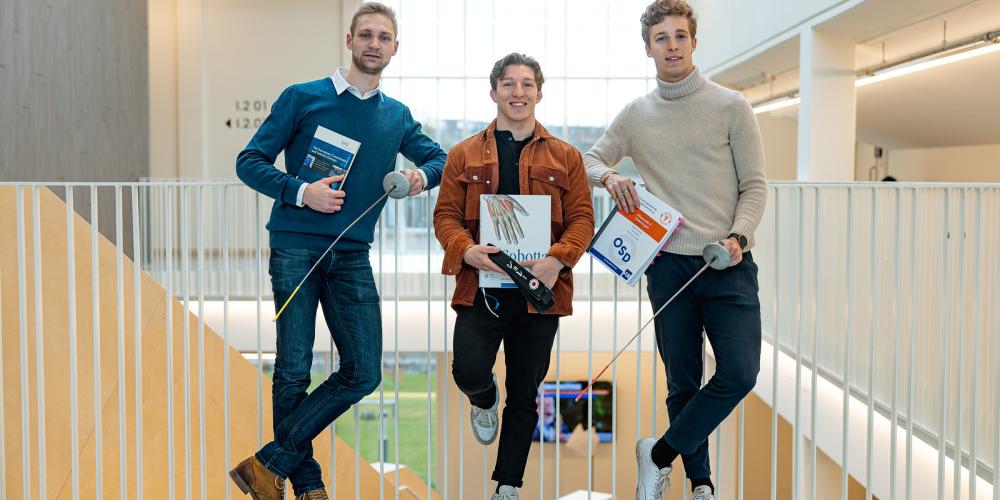
During the 2022-2023 academic year, 119 top athletes and followed a flexible study path at the Vrije Universiteit Brussel. Over the years, VUB researchers have developed a scientifically substantiated policy to support athletes such as Belgian Cat Antonia Delaere and sprinter Jonathan Sacoor, both academically and mentally. “Our mission is to provide maximum study flexibility so that top athletes can develop optimally in their own sporting environment,” says Professor Koen De Brandt, coordinator of the Top Sport & Study service.
In 2022, the service received the Athletes Friendly Education Award from the Belgian Olympic and Interfederal Committee, for its “unwavering commitment to student athletes”. It is not just concerned with practical matters such as moving exams or staggering study years, but mental well-being of high-level athletes is also central. “We really focus on support,” says De Brandt. “Our Top Sport & Study service is closely linked to the Sports Psychology and Mental Counselling research group. Together we carry out research into the mental well-being of high-level athletes. We use tools to screen and monitor them. This begins as early as the application for top-level sports status and during the intake interview. We screen for mental well-being, prevalence of mental problems, stress and recovery. We also look at their experiences of combining high-level sport and studying. Once the academic year begins, we monitor the students. We carry out a survey every two month about satisfaction in terms of sport, studying, social well-being, mental well-being, physical health, sleep and nutrition. That’s how we maintain contact with the students. The monitoring helps us to follow up with students efficiently and to identify any worrying issues.”
For the VUB service, it’s important that students gain the necessary skills via individual guidance, and via a quiz about dual careers and mental well-being and workshops throughout the year. These cover planning, setting goals and dealing with stress, but they also look at issues such as socially responsible entrepreneurship and social media. “We’ve moved away from the idea of only measuring things,” says De Brandt. “So we created a tool where students not only evaluate themselves but they also get immediate feedback. They learn about their own development as top-level sports students. We give students the academic flexibility they need, and want to help them develop certain skills that make the combination of study and top-level sport possible. Our interactive Dual Career Tools platform is based on scientific research and helps active athletes, former athletes and coaches to gain more insight into their skills. What do they need for a successful combination of top sport and studying, a successful transition to the labour market or high-quality coaching of top athletes in dual careers? Using the tool, we help them reflect on this and take control of their own development.”
In the academic year 2022-2023, the 119 top athletes were spread across 30 study programmes. “About 40% were in the Faculty of Physical Education and Physiotherapy, 60% were in other faculties,” says De Brandt. Rehabilitation Sciences and Physiotherapy had 27 students and Exercise and Sports Sciences had 22. Courses such as Criminology (6), Medicine (6), Bioengineering (5), Business Engineering (5), Applied Economics (5) and Engineering (5) also attract top athletes. “I combined sport and studying at VUB myself, I studied Exercise and Sports Sciences,” says De Brandt. “VUB is the only university in Europe with a specific pathway for athletes at the highest level of sport and movement science. While regular students have their sports subjects, elite athletes follow a specific pathway in which they systematically analyse their own career. We give them the opportunity to study sports and exercise science without being overloaded by sports subjects. So we attract many Olympic-level athletes.”
The Top Sport & Study service began in the 1987-1988 academic year as a project with 25 student athletes and was created by former rector Paul De Knop and Professor Paul Wylleman. Since then, the initiative has taken off, and Wylleman and coordinator De Brandt have coached more than 1,000 top student athletes. The group contains not only several Olympians, but also several Olympic medallists.
In addition to their professional performances, these athletes earned academic degrees. “Our mission is to provide maximum study flexibility so that top athletes can develop optimally in their own sporting environment,” says De Brandt. “A typical student athlete takes an average of 45 credits but that depends very much on athletic level, training and timing. For example, some students take fewer credits during an Olympic year. The flexible status allows self-study, legitimate absence during practicals or rescheduling of exams. It’s not our intention to set up a central training centre at VUB. Among others, we’re coaching a Belgian snowboarder, a Dutch volleyball player and a Canadian ballet dancer who only come to campus during exam periods. We have been attracting more and more top international athletes in recent years with our English-language programmes, such as the bachelors in Social Sciences and Business Economics.”